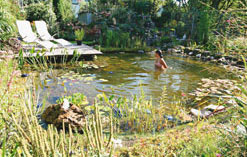A natural swimming pond looks like a natural garden pond, but is specifically designed to swim in clean, pure water with no chemicals in it. The difference between a swimming pond and a swimming pool is that a swimming pool uses chemicals such as chlorine to kill bacteria, whereas a swimming pond cleanses the water naturally. It uses the purifying properties of plants, a filter to extract surface debris such as leaves, and a pump to keep the water circulating through the planting area.Nevertheless, the water quality has to be checked regularly to make sure that the bathers are safe under all circumstances, e.g. microorganism and other biological, chemical and physical components.
Bathing Water
 This applies to any water where the authorities expect a large number of people to bathe and has not imposed a permanent bathing prohibition, or issued advice against bathing. It is the responsibility of the authorities to identify and assess causes of pollution that might affect bathing waters and impair bathers´ health during the bathing season.The basis for the regular control of all public used natural swimming ponds is the European Directive „2006/7/EG of the European Parliament, dated 15th February 2006.
This applies to any water where the authorities expect a large number of people to bathe and has not imposed a permanent bathing prohibition, or issued advice against bathing. It is the responsibility of the authorities to identify and assess causes of pollution that might affect bathing waters and impair bathers´ health during the bathing season.The basis for the regular control of all public used natural swimming ponds is the European Directive „2006/7/EG of the European Parliament, dated 15th February 2006.
Microbiological, chemical and physical quality criteria
Water quality includes all physical, chemical and biological factors that influence the beneficial use of water. There are many water quality variables in natural swimming ponds and bathing water in general. These are the most important criterias:
Mikrobiology
- Escherichia coli
- Enterococci
- Pseudomonas aeroginosa
- Legionella pneumophila
- Cyano bacteria
Parasites
- e.g. Cryptosporidia
Chemical and physical characteristics
Dissolved Oxygen
Dissolved oxygen is probably the most critical quality variable in the water. Oxygen levels in pond systems depend on water temperatures, the water salinity, and the amount of aquatic vegetation and animals
pH-value
The pH-value is the determination of the hydrogen ion (H+) concentration in water. The pH scale ranges from 0-14 with a pH of 7 being neutral. A pH below 7 is acidic and an pH of above 7 is basic. An optimal pH range is between 6.5 and 8.5, however it should not be lower than pH5 or above pH9. pH will vary depending on a number of factors. The pH may rise during the day as phytoplankton and other aquatic plants remove CO2 from the water during photosynthesis. The pH decreases at night because of respiration and production of CO2 by organisms. The fluctuation of pH levels will depend on algae levels as well
Temperature
Temperature will affect all chemical and biological processes. Temperature therefore has a direct effect on important factors such as growth and oxygen demand. The higher the temperature, the greater the requirement for oxygen and the faster the growth rate of the plants.
Ammonia
Ammonia is produced from the decomposition of organic wastes resulting in the breakdown of decaying organic matter such as algae and plants. Ammonia levels will depend on the temperature of the water and its pH. For example at a higher temperature and pH, a greater number of ammonium ions are converted into ammonia gas thus causing an increase in toxic ammonia levels within the freshwater.
Nutrient levels
Nutrient levels refer to the amount of phosphorus and nitrogen that are present in the water. Increased levels of nutrients may be harmful. It can cause excessive plankton growth, potential blue-green algae and oxygen depletion.